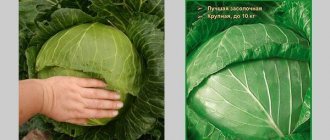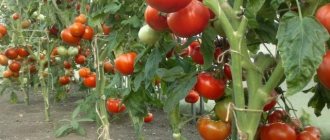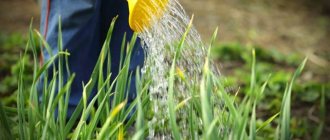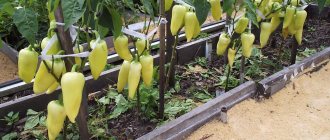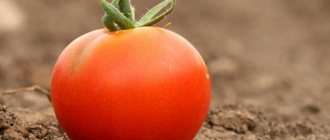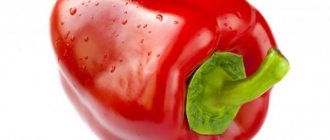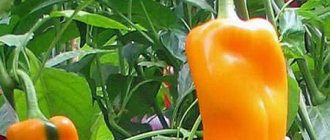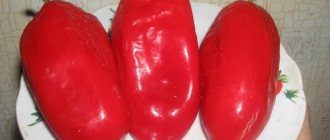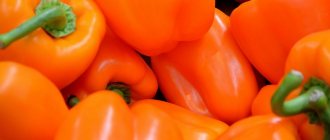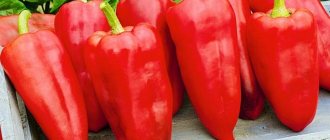In the line of sweet peppers of Dutch selection, hybrids have been bred that have successfully shown themselves in the conditions of Russian regions. Among them is Claudio pepper, the description and characteristics of which attract summer residents from the south of the country, the middle zone and even harsh Siberia. The early-ripening hybrid is valued for its excellent yield, low susceptibility to disease, and excellent taste.
What kind of pepper is this
Claudio f1 is a highly productive hybrid of sweet pepper. When growing it, you can always count on a rich, healthy harvest, since it is able to form ovaries even under unfavorable conditions.
Characteristics and description
The species belongs to early ripening crops (no more than 115 days). The bushes are powerful, spreading, with large dark green wrinkled leaves. Height is about 70 cm. Each grows 10–12 fruits weighing up to 200 g with a wall thickness of 8–10 mm.
The plant feels great both in a greenhouse and in open ground. Seed germination is almost 100%. Can be grown both in greenhouses and in open ground.
The fruits are prismatic, with four chambers. They have high taste value.
The photo shows Claudio pepper f1.
Hybrid f1
The f1 hybrid is the result of long-term work by breeders. To obtain new types of crops, intraspecific plant crossings are carried out. The result of this work is new hybrids that are superior to their parents in key indicators: yield, taste, ripening time and, most importantly, disease resistance and frost resistance.
The F1 symbol present in the name of the Claudio pepper indicates that it is a first generation hybrid obtained from direct crossing of parent varieties. The hybrid form is highly productive. The description of the plant was officially included in the State Register of Russia in 2007.
Claudio F1 sweet pepper plant (Bayer Nunhems) crop in the field
Distinctive features
Claudio f1 is known to all experienced gardeners. Recommended for cultivation in the southern regions of the country. Has the following positive characteristics:
- is characterized by increased resistance to high ambient temperatures;
- suitable for long-term transportation and can be stored for up to two months (if collected at the stage of technical maturity);
- seed germination is high (96–100%);
- good fertility of relatively small bushes;
- low rate of transition from the stage of technical maturity (green fruits) to the biological stage (bright red, characteristic of a ripe vegetable).
Fruit characteristics and yield
The hybrid produces glossy, drooping, prism-shaped fruits. Green at the stage of technical maturity and red at biological maturity. The weight of one pepper is 100–150 g. The walls are fleshy, juicy, 8–10 mm thick.
The yield, subject to all technological cultivation standards, is almost 300 c/ha.
Main characteristics of culture
The hybrid form of pepper is deservedly considered to be a fairly promising and highly productive plant, forming a medium-height bush with medium-spreading pagons. The variety can be recognized by its dark green leaves with pronounced veins of a lighter shade. The structure of the leaf is distinguished by a somewhat wrinkled and rough surface.
The main advantage of the “Claudio” variety is the plant’s resistance to dry and hot weather, which is often observed in the summer in our country.
The hybrid is also immune to the tobacco mosaic and mottle virus, which is quite popular among vegetables. Important! Growing the crop on open plots of land or in specially equipped greenhouses in the North Caucasus region of Russia will be especially productive.
The bushes of the plant produce beautiful fruits in the shape of a prism with a smooth surface and a characteristic glossy shine. At technical maturity, peppercorns are green in color, which gradually changes to deep red. The fruits have relatively fleshy walls, 6.5-7.8 mm thick, and weigh about 100-200 g.
Preparation for cultivation
Claudio pepper, like any nightshade, is grown from seedlings. Before planting, the seeds must be sorted and damaged ones removed. A mandatory procedure is to soak them in warm water until they swell. After this, they are transferred to a damp cloth or gauze, covered with a second layer and waited for 3-4 days.
After this, the planting material is treated with a biostimulant such as Epin, Zircon or Kornevin.
Attention! If the seeds are covered with a yellow shell, it means that the manufacturer has disinfected them in advance. It is not advisable to do this again.
Seeds are planted in boxes or cups with loose fertile soil. You can buy it in a store or make it yourself by mixing garden soil, sand and humus in equal proportions. Adding a small amount of wood ash has a good effect. The mixture is heated in the oven, allowed to cool and then distributed into cups or boxes. Depending on the region, pepper seedlings are planted from February to March.
Growing seedlings
The seeds are planted in prepared soil to a depth of about 2 cm. It is best to do this in separate pots, otherwise picking will be required, during which the young roots of the plant can be damaged and the harvest can be lost. After planting, the soil is watered and covered with film. For future seedlings, you need to choose a warm place.
After the first shoots appear, the film is removed. At this stage, the most important factor affecting the quality of future plants is temperature. Even at night it should not fall below 12°C. You can spray and water young peppers only with warm, settled water. The room in which the seedlings are located should be well ventilated and illuminated 10–12 hours a day.
Important ! Many gardeners believe that growing seedlings in peat pots has a bad effect on the quality and strength of the adult plant.
If the plant was planted in a separate container, then after the first buds begin to form, it is immediately planted in open ground or a greenhouse.
If the seedlings were planted in a box, then picking is important.
This is an important event that allows you to:
- prevent the roots of different plants from intertwining;
- discard diseased and weak shoots at this stage, obtaining stronger bushes;
- ultimately reap more good harvests.
Picking should be done carefully and slowly. It is carried out at the stage of 2-3 true leaves, until the root system of the plant has formed. When transplanting into a new container, take into account the depth of the sprout in the previous container. You can’t dig the pepper down to the cotyledon leaves.
Immediately after transplantation, the plant will be under stress. It is better to remove it from direct sunlight for several days and ensure the ambient temperature is 20–22 °C. After 14 days, you can fertilize with ready-made fertilizer.
Important! Do not over-moisten the soil, otherwise root rot and plant death may occur.
Planting pepper
Peppers are planted in open ground at the end of May, when the air temperature does not drop below 15°C even at night. It is important to observe crop rotation. The best predecessors of pepper are pumpkin and zucchini. It is not advisable to plant after potatoes and eggplants. The plant prefers soil with low acidity, light and loose.
Claudio peppers are planted in small holes (without deepening the root collar) at a distance of 40 cm from each other. It is advisable to pour 1 tbsp into each hole. l. fertilizers high in nitrogen or phosphorus. At the end of planting, the plants are watered abundantly.
Further care
The Claudio hybrid is unpretentious, but to obtain a good harvest, some agrotechnical manipulations are required:
- removing lower leaves and providing good support;
- if the bush has formed from several stems, only the strongest ones are left (it’s best to pinch them with your hands);
- The flower grown on the first branch is removed, thereby increasing the yield.
- timely and abundant watering;
- loosening the soil under the bushes;
- The ideal temperature is 22–25°C.
- Until flowering, just one watering per week is enough; after the first flowers appear, watering is increased up to two times.
Agricultural technology for growing "Claudio F1"
To ensure a good harvest, you need to care for the pepper bushes. Professionals recommend removing the central flower on each plant. Thanks to this action, there will be more harvest. And also, in order to increase the yield, the bushes need to be formed into 3 stems, removing the side shoots that form in a timely manner.
Soil care and weeding
Sweet peppers love loosened soil. Therefore, you need to make sure that there is no earthen crust. Loosening improves air flow to the roots. During the first 14 days, pepper grows slowly, and it is not advisable to loosen the soil, as the roots become stronger. Later, it is necessary to loosen the soil after watering, when it has dried, but a crust has not yet formed. This should be done no deeper than 5 cm, since the roots are in the top layer of the earth. It is also advisable to carry out weeding, thereby getting rid of weeds. Peppers need to be hilled during flowering.
Watering and fertilizing
You need to water the pepper once every 7 days, until it begins to bloom. For 1 sq. m use 12 liters of water. When the bushes have bloomed, it is worth watering 3 times a week, using 14 liters of water. The water must be settled and have a temperature of 24–26 °C. 14 days after the pepper is planted in the ground, it is fed for the first time. For this purpose, manure and chicken droppings are used, mixed with phosphorus-potassium fertilizers. Or you can use mineral fertilizers: saltpeter, superphosphate, potassium chloride. The following fertilizing is carried out at the beginning of fruiting and during the formation of fruits, increasing the dose of ammonium nitrate.
Important! If the fruits are small, you can feed the plant a fourth time.
pepper garter
The “Claudio F1” variety has very fragile shoots, and any careless movement can damage them, so it is necessary to tie the stems to pegs
Typical diseases and pests
Diseases and pests are generally standard for the entire species.
In conditions of high humidity, fungal diseases develop. To combat, reduce watering and spray the bushes with Barrier and Oksikhom. Repeated treatment is necessary after 20–25 days.
Reference . Hybrid Claudio f1 is not susceptible to such a dangerous disease as tobacco mosaic.
Often the plant is attacked by the main garden pests: aphids, wireworms and spider mites.
An infusion of onion peels helps against spider mites.
A solution of wood ash works well against aphids.
For wireworms, they set traps from sweet root vegetables, which they like more than pepper.
Features of the variety
The hybrid was bred for cultivation in conditions of high illumination and a warm climate, therefore it has characteristics of ripening and yield.
Did you know? The first written mentions of sweet peppers date back to the mid-15th century
- the personal physician of Christopher Columbus, who appreciated the medicinal properties of peppers in the fight against scurvy, spoke extremely positively about them.
Ripening time
On average, the growing season for Claudio pepper lasts from 70 to 80 days, but in the middle zone this period extends to 90 and even 105 days. The acquisition of the desired color by the fruit directly depends on the number of sunny days - the more there are, the sooner the pepper becomes suitable for harvesting.
Productivity
Initially, the hybrid was supposed to bear up to 12 fruits weighing 210–250 g on one bush, and also have a yield within 5 kg per 1 m². Plants grown in middle and northern latitudes form 6–8 fruits on one shoot, so their yield is reduced to 3–3.5 kg per 1 m², respectively. Greenhouse cultivation allows for higher planting productivity.
Advantages and disadvantages
Claudio pepper is valuable for its fruits. Large, thick-walled, thin-skinned peppers have a bright aroma and excellent taste. An early ripening crop with a growing season of 80 days. Shows high productivity. Resistant to diseases and pests.
The hybrid easily tolerates temperature changes. Not afraid of sunburn and frost. Hard fruits are suitable for long-term transportation.
It can be grown both in greenhouses and in open ground.
It would seem that this is an ideal pepper hybrid, however, it also has disadvantages. You can get a good harvest only by devoting enough time to growing the crop. The bush requires feeding, loosening, watering and garter. The level of lighting is important. Only with proper care can you reap a decent harvest.
The fruits have good shelf life only if collected during the period of technical ripeness. Peppers collected at the moment of biological maturity cannot be stored for long.
Rules for caring for crops
The procedure for growing a hybrid form of sweet pepper from foreign breeders is not too burdensome, and therefore the culture is popular both among professionals and among amateur vegetable growers. However, to obtain optimal yield of this garden crop, the following recommendations on agricultural technology must be followed:
- Maintaining an ambient temperature of about 22°C for the first growing season and 25-27°C during the mass ripening of fruits.
- A sufficient amount of sunlight contributes to the rapid growth and development of the plant, and the fruits acquire a regular and symmetrical shape.
- When growing “Claudio” sweet peppers in your own garden, it is extremely important to promptly prevent the bushes from such pests of nightshade crops as May beetle larvae, aphids, whiteflies, etc. Both special preparations and traditional methods are suitable for processing the plant.
- It is recommended to water the beds after sunset with water that has settled and preheated to a temperature of 30°C. To implement this procedure, both a manual method and a drip irrigation system are suitable.
- Before flowering, the crop should be fertilized with organic fertilizers, for example, rotted manure or compost. When the ovary appears, you can fertilize the plant with phosphorus compounds, and during the period of fruit ripening - with potassium substances.
To improve the basic characteristics of bell peppers and faster ripening of fruits, it is recommended to form a bush of 1,2 or 3 stems. To create a highly productive garden plant, only the strongest shoots need to be left, and the remaining shoots should be removed. This procedure allows the pepper to redistribute the supply of nutrients to the fruits, which in turn guarantees their faster ripening and acquisition of excellent taste.
Reviews
Gardeners who have tried to grow the Claudio hybrid are generally satisfied with the resulting harvest.
Irina, Ryazan: “I bought Claudio pepper seeds in a specialized store on the advice of a neighbor. I wasn't disappointed. The fruits began to ripen quickly, fleshy, bright red in color. I prepared it for the winter and used it in salads all summer.”
Tamara, Ivanteevka: “ Claudio pepper has been ripening on my plot for several years now. I plant only in a greenhouse, so the harvest ripens two weeks earlier than in open ground. Of course, the hybrid requires attention: watering, fertilizing, treating so that the bushes do not get sick. But the result does not disappoint. Large, fleshy peppers delight the eye and heart.”
Vladimir, Kostroma: “I’ve been trying to grow Claudio pepper on my plot for the second season. In general, I like the hybrid: tasty fruits, fleshy, bright red. But they ripen longer than stated in the manufacturer’s description.”
